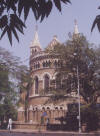|
|
the-south-asian.com January 2008 |
|
|||
|
Health Films
- Book Reviews Heritage
People
|
|
||||
|
Page
2 of 3 Heritage Conservation - South Asian Winners (cntd) The
Convocation Hall, Mumbai The 133-year-old Mumbai University’s Cowasji Jehangir Convocation Hall, designed in the Neo-Gothic style by British architect Sir George Gilbert Scott, was built in 1869-74, and funded by the Parsi philanthropist Sir Cowasji Jehangir Readymoney. Over its history, the convocation hall had not undergone any major repairs. Leakages from its tiled roof, termite infestation in its Burma teak beams, disappearing gilt, and stained glass in disrepair – these were only some of the major problems to contend with. The restoration of the Convocation Hall began in 2005. The project, led by Mumbai-based conservation architect Abha Lambah, focused on structural conservation, upgrading services and restoring the interior to ensure that the building could be functional once again. It now serves as a hall for public uses and ceremonies. Sir George had embellished the 104 feet long, 44 feet wide, and 63 feet high convocation hall with gilt, gargoyles and stained glass to create a definite architectural impact. “Over 2,000 square feet of stained glass crafted at the London studios of Heaton, Butler and Bayne had been shipped to Bombay (now Mumbai) in 1873.” The huge circular window (24-feet in diameter), also known as the rose window, has a design of the Zodiac signs. The Cowasji Jehangir Convocation Hall has been restored, at a cost of Rs 1.9 crore, to its original elegance.
Galle Fort Hotel, Galle Award of Distinction Galle Fort Hotel is located in the heart of the Galle Fort first established by the Portuguese in the 1500s. The Dutch rebuilt the fort a century later (when it served as HQ for the Dutch East India Company), and it passed into British hands in 1796. The hotel is owned by Chris Ong and Karl Steinberg, who gave up careers in finance and film-making in Sydney to transform the derelict 17th-century Dutch house into a stylish luxury boutique hotel, and in doing so captured the original spirit of the place as well as of the colonial World Heritage fortified town of Galle. The restoration work on this abandoned historic residence was carried out with great sensitivity and by using local expertise and craftsmanship. The original scale of the building and its street façade has been retained. The restoration process revealed the original Dutch villa and its later English architectural influences. Chris Ong and Karl Steinberg bought the property in 2003 and after 18 months of painstaking restoration the hotel opened in December 2004 - only to be converted into a temporary emergency shelter in the aftermath of the 2004 tsunami. The subsequent contribution of the hotel to the recovery of Galle through cultural tourism has demonstrated the potential of such commercial ventures to contribute to community development in an historic urban heritage context.
|
|||||
|
Copyright © 2000 - 2008 [the-south-asian.com]. Intellectual Property. All rights reserved. |
|||||


